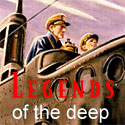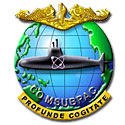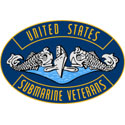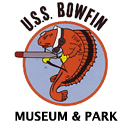The following is the conclusion of Chuck Thompson's summary of the wreck footage. Legends wishes to thank Chuck for his permission to share his summary which is the result of long hours pouring over the video. It picks up following the shots of the damage to the conning tower fairwater with the camera diver moving forward up the port side of the CTF:
At 13:00 the port side radio transmitter insulator is visible.
At 13:02 a close up of the radio insulator is presented. No damage visible.
At 13:07, the video shifts to dark footage swimming forward along the port side of the CTF forward of the damaged area. The forward 20mm platform is coming into view.
At 13:16 video shift to different footage swimming along the port side of the CTF, forward of the damage.
At 13:23 the diver is approaching the forward 20mm platform. The ready service locker and 20 mm mount become visible when,
At 13:24 new video looking forward from the port side of the CTF, below the bridge. The fwd 20mm platform and 20 mm mount are visible, along with the 4” deck gun and much of the fore deck. The 20 mm mount is out of alignment (it should be fore and aft) from its normal stowed position. Possibly fishing net (Post war trawl) damage after loss?? Wood on the fwd cigarette deck and ready service locker are visible. All railing is gone.
At 13:26 different video, swimming forward to port of CTF. 20 mm mount is in the center of the photo.
At 13:28 a close up of the fwd 20mm platform ready service locker, and
At 13:29 close up of the 20 mm mount.
At 13:32 different footage of the fwd 20 mm mount.
At 13:32 different footage of the fwd 20 mm mount, looking aft toward the bridge. With the exception of the 20mm mount being rotated approximately 90 degrees (probably the result of fishing nets), no damage is visible.
At 13:46 more different footage of the 20 mm mount, looking aft and up
At 13:47 image fades to where we left off at 13:27, close up of ready service locker and fwd 20mm platform. Film continues forward toward the bow, over the 4” deck gun.
At 13:57 camera is looking under the 4” deck gun, pans to starboard as the forward lower part of the CTF comes into view on the right, and a diver is in the background. While there is marine growth on deck, no damage is visible.
At 14:08 camera swimming over the fore deck, 4” barrel visible to right, sonar to left. Only the port side of the deck is clear.
At 14:16 the deck access (escape trunk) hole (rectangular opening in the deck) is visible. The fwd escape hatch is just forward of this hole, but is buried under marine growth. It appears to be closed.
At 14:19 the fwd port diving plane is somewhat visible.
At 14:29 video changes, and the fwd port diving plane is more visible.
At 14:36 footage shifts to the bow. The fwd capstan is visible. Some metal decking is missing aft of the capstan. This should be in place.
At 14:48 fwd of the capstan is another missing piece of plate or cover which should be in place.
At 15:02 the bull nose comes into view.
At 15:12 the video shifts to the bull nose from forward and to port, moving aft. The fwd port diving plane is barely visible, appears to be level.
At 15:21 camera is moving aft along the deck along the port side deck edge.
At 15:51 one can possibly see the fwd escape hatch to the left. It should be there, but is covered with marine growth. Appears to be closed.
At 15:56 shift to fwd of 4” deck gun moving aft at deck lever, slightly to starboard.
At 16:00 more footage of the 4” deck gun.
At 16:17 the fwd 20mm platform is visible over the 4” deck gun.
At 16:27 video shifts to moving aft over the 4” deck gun slightly to port. The bridge superstructure is clear. Unknown debris seen earlier from astern is visible protruding from the superstructure at the level of the starboard lookout platform.
At 16:27, back to the 4” deck gun. Gun is in proper fore/aft alignment.
At 16:35 different footage of the 4” deck gun looking fwd to starboard, from aft of the gun.
At 16:43 more different footage of the 4” deck gun, this time swimming aft slightly to starboard.
At 16:46 the periscope sheers, covered in line.
At 16:50 different footage of the sheers, looking up from the starboard bridge area. SJ antenna to right, trained to port.
At 16:57 video shifts to looking directly at the sheers from starboard to port. SJ antenna is visible to right; periscopes are wrapped in fishing lines. No damage visible.
At 17:09 video shifts to the lower sheers, again looking from starboard to port. Lower SJ support is visible along with the #1 periscope sheer. Camera pans aft to the SD mast. A new flagstaff near SD, installed during last overhaul, is visible, wrapped in fishing lines. No damage other than natural corrosion is visible.
At 17:09 the rectangular D/F loop mounted on the starboard side of the sheers is visible.
At 17:14 video shifts to both periscopes, apparently fully raised, wrapped in trawl lines.
At 17:26 video shifts to more distant footage of the starboard sheers.
At 17:32 image fades and shifts almost 180 degrees, and is now looking at the port side of the sheers, moving aft. This is neatly done, and one hardly notices the shift of 180o.
At 17:48 camera now moving aft along the port side of the CTF, fwd of battle damaged area, just above the level of the cigarette deck.
At 17:55 camera moves past the aft end of the bridge, above the damaged area. The free standing aft end of the CTF is visible.
At 17:57 what appears to be the engine exhaust induction is visible just forward of the free standing aft end of the CTF. The area of heavy damage below is not visible. The divers “down line” is visible.
At 18:17 the camera has moved past the free standing aft end of the CTF and is continuing to move toward the stern.
At 18:29, moving aft along the deck, the deck turns from teak to steel.
At 18:35 there is missing deck plating to port.
At 18:40 there is significant missing deck plating. Support structure appears undamaged.
At 18:55 there is another missing deck plate to port. The deck is in pretty good shape from here aft.
At 19:06 there is another smaller missing deck plate to port.
At 19:10 the camera is approaching the stern. The closed chock is visible, as is the capstan. The after torpedo room hatch is covered with sea growth, but appears to be closed.
From 19:20 through 19:30 the diver swims around the stern closed chock, and moves forward along the starboard side.
At 19:25 there is plating missing to port and below the after closed chock.
At 19:34 the camera is looking forward from starboard over the after capstan.
At 19:35 the camera is moving forward along the starboard side. The After Torpedo Room (ATR) hatch or the ATR torpedo loading hatch is visible but covered in marine growth.
At 20:07 the damage deck plating damage visible at 18:45 is seen from starboard. This much missing plating cannot be natural. Again the supporting structure appears undamaged. There are lots of fish above the missing deck plating (as would be expected.).
At 20:25 another missing deck plate to starboard is visible.
At 20:30 the after deck 20mm mount comes into view.
At 20:32 the conning tower fairwater (CTF) is visible from aft.
At 20:50 the starboard bomb damage is visible but not clear. Approaching the fairwater from astern and starboard.
At 20:53 video shifts to moving aft at the after (tapered) end of the conning tower fairwater. Moving from starboard, the diver swims around the aft end of the CTF. The CTF plating is badly deteriorated.
At 20:57 the diver is swimming forward along the port side from the aft taper of the CTF, moving forward at deck level.
At 21:02 the teak deck to port of the CTF is visible.
At 21:04 the shaft of the DF loop is clearly visible, blown forward. The after conning tower bulkhead should be a few feet forward. The CTF appears to be missing aft from the port and starboard fairwater access.
At 21:05 the camera pans upward to the after end of the lookout platform, looking from aft and port.
At 21:08 seen shifts to looking at the CTF from aft at the level of the lookout platform, looking directly forward. We’ve seen this sequence before. This sequence is also running backwards as, upon close examination, the fish are swimming backwards.
21:15 pan to looking down on the lookout platform from aft – drifting upward. Wahoo fading out.
21:21 Good view of damaged area from above – damaged area just a black hole.
21:24 End of video.
Continue Reading
At 13:00 the port side radio transmitter insulator is visible.
At 13:02 a close up of the radio insulator is presented. No damage visible.
At 13:07, the video shifts to dark footage swimming forward along the port side of the CTF forward of the damaged area. The forward 20mm platform is coming into view.
At 13:16 video shift to different footage swimming along the port side of the CTF, forward of the damage.
At 13:23 the diver is approaching the forward 20mm platform. The ready service locker and 20 mm mount become visible when,
At 13:24 new video looking forward from the port side of the CTF, below the bridge. The fwd 20mm platform and 20 mm mount are visible, along with the 4” deck gun and much of the fore deck. The 20 mm mount is out of alignment (it should be fore and aft) from its normal stowed position. Possibly fishing net (Post war trawl) damage after loss?? Wood on the fwd cigarette deck and ready service locker are visible. All railing is gone.
At 13:26 different video, swimming forward to port of CTF. 20 mm mount is in the center of the photo.
At 13:28 a close up of the fwd 20mm platform ready service locker, and
At 13:29 close up of the 20 mm mount.
At 13:32 different footage of the fwd 20 mm mount.
At 13:32 different footage of the fwd 20 mm mount, looking aft toward the bridge. With the exception of the 20mm mount being rotated approximately 90 degrees (probably the result of fishing nets), no damage is visible.
At 13:46 more different footage of the 20 mm mount, looking aft and up
At 13:47 image fades to where we left off at 13:27, close up of ready service locker and fwd 20mm platform. Film continues forward toward the bow, over the 4” deck gun.
At 13:57 camera is looking under the 4” deck gun, pans to starboard as the forward lower part of the CTF comes into view on the right, and a diver is in the background. While there is marine growth on deck, no damage is visible.
At 14:08 camera swimming over the fore deck, 4” barrel visible to right, sonar to left. Only the port side of the deck is clear.
At 14:16 the deck access (escape trunk) hole (rectangular opening in the deck) is visible. The fwd escape hatch is just forward of this hole, but is buried under marine growth. It appears to be closed.
At 14:19 the fwd port diving plane is somewhat visible.
At 14:29 video changes, and the fwd port diving plane is more visible.
At 14:36 footage shifts to the bow. The fwd capstan is visible. Some metal decking is missing aft of the capstan. This should be in place.
At 14:48 fwd of the capstan is another missing piece of plate or cover which should be in place.
At 15:02 the bull nose comes into view.
At 15:12 the video shifts to the bull nose from forward and to port, moving aft. The fwd port diving plane is barely visible, appears to be level.
At 15:21 camera is moving aft along the deck along the port side deck edge.
At 15:51 one can possibly see the fwd escape hatch to the left. It should be there, but is covered with marine growth. Appears to be closed.
At 15:56 shift to fwd of 4” deck gun moving aft at deck lever, slightly to starboard.
At 16:00 more footage of the 4” deck gun.
At 16:17 the fwd 20mm platform is visible over the 4” deck gun.
At 16:27 video shifts to moving aft over the 4” deck gun slightly to port. The bridge superstructure is clear. Unknown debris seen earlier from astern is visible protruding from the superstructure at the level of the starboard lookout platform.
At 16:27, back to the 4” deck gun. Gun is in proper fore/aft alignment.
At 16:35 different footage of the 4” deck gun looking fwd to starboard, from aft of the gun.
At 16:43 more different footage of the 4” deck gun, this time swimming aft slightly to starboard.
At 16:46 the periscope sheers, covered in line.
At 16:50 different footage of the sheers, looking up from the starboard bridge area. SJ antenna to right, trained to port.
At 16:57 video shifts to looking directly at the sheers from starboard to port. SJ antenna is visible to right; periscopes are wrapped in fishing lines. No damage visible.
At 17:09 video shifts to the lower sheers, again looking from starboard to port. Lower SJ support is visible along with the #1 periscope sheer. Camera pans aft to the SD mast. A new flagstaff near SD, installed during last overhaul, is visible, wrapped in fishing lines. No damage other than natural corrosion is visible.
At 17:09 the rectangular D/F loop mounted on the starboard side of the sheers is visible.
At 17:14 video shifts to both periscopes, apparently fully raised, wrapped in trawl lines.
At 17:26 video shifts to more distant footage of the starboard sheers.
At 17:32 image fades and shifts almost 180 degrees, and is now looking at the port side of the sheers, moving aft. This is neatly done, and one hardly notices the shift of 180o.
At 17:48 camera now moving aft along the port side of the CTF, fwd of battle damaged area, just above the level of the cigarette deck.
At 17:55 camera moves past the aft end of the bridge, above the damaged area. The free standing aft end of the CTF is visible.
At 17:57 what appears to be the engine exhaust induction is visible just forward of the free standing aft end of the CTF. The area of heavy damage below is not visible. The divers “down line” is visible.
At 18:17 the camera has moved past the free standing aft end of the CTF and is continuing to move toward the stern.
At 18:29, moving aft along the deck, the deck turns from teak to steel.
At 18:35 there is missing deck plating to port.
At 18:40 there is significant missing deck plating. Support structure appears undamaged.
At 18:55 there is another missing deck plate to port. The deck is in pretty good shape from here aft.
At 19:06 there is another smaller missing deck plate to port.
At 19:10 the camera is approaching the stern. The closed chock is visible, as is the capstan. The after torpedo room hatch is covered with sea growth, but appears to be closed.
From 19:20 through 19:30 the diver swims around the stern closed chock, and moves forward along the starboard side.
At 19:25 there is plating missing to port and below the after closed chock.
At 19:34 the camera is looking forward from starboard over the after capstan.
At 19:35 the camera is moving forward along the starboard side. The After Torpedo Room (ATR) hatch or the ATR torpedo loading hatch is visible but covered in marine growth.
At 20:07 the damage deck plating damage visible at 18:45 is seen from starboard. This much missing plating cannot be natural. Again the supporting structure appears undamaged. There are lots of fish above the missing deck plating (as would be expected.).
At 20:25 another missing deck plate to starboard is visible.
At 20:30 the after deck 20mm mount comes into view.
At 20:32 the conning tower fairwater (CTF) is visible from aft.
At 20:50 the starboard bomb damage is visible but not clear. Approaching the fairwater from astern and starboard.
At 20:53 video shifts to moving aft at the after (tapered) end of the conning tower fairwater. Moving from starboard, the diver swims around the aft end of the CTF. The CTF plating is badly deteriorated.
At 20:57 the diver is swimming forward along the port side from the aft taper of the CTF, moving forward at deck level.
At 21:02 the teak deck to port of the CTF is visible.
At 21:04 the shaft of the DF loop is clearly visible, blown forward. The after conning tower bulkhead should be a few feet forward. The CTF appears to be missing aft from the port and starboard fairwater access.
At 21:05 the camera pans upward to the after end of the lookout platform, looking from aft and port.
At 21:08 seen shifts to looking at the CTF from aft at the level of the lookout platform, looking directly forward. We’ve seen this sequence before. This sequence is also running backwards as, upon close examination, the fish are swimming backwards.
21:15 pan to looking down on the lookout platform from aft – drifting upward. Wahoo fading out.
21:21 Good view of damaged area from above – damaged area just a black hole.
21:24 End of video.









